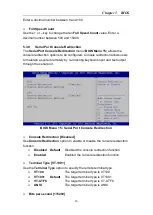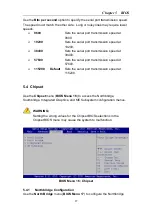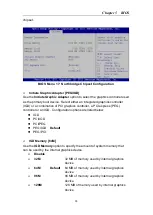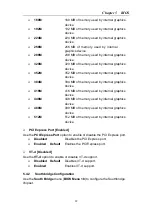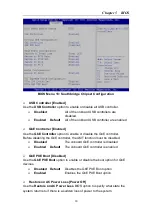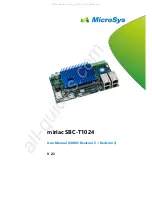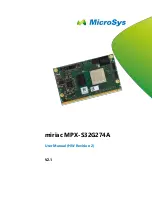
Appendix B Terminology
100
DIO
The digital inputs and digital outputs are general control signals
that control the on/off circuit of external devices or TTL devices.
Data can be read or written to the selected address to enable the
DIO functions.
EHCI
The Enhanced Host Controller Interface (EHCI) specification is a
register-level interface description for USB 2.0 Host Controllers.
EIDE
Enhanced IDE (EIDE) is a newer IDE interface standard that has
data transfer rates between 4.0 MBps and 16.6 MBps.
EIST
Enhanced Intel
®
SpeedStep Technology (EIST) allows users to
modify the power consumption levels and processor
performance through application software. The application
software changes the bus-to-core frequency ratio and the
processor core voltage.
FSB
The Front Side Bus (FSB) is the bi-directional communication
channel between the processor and the Northbridge chipset.
GbE
Gigabit Ethernet (GbE) is an Ethernet version that transfers data
at 1.0 Gbps and complies with the IEEE 802.3-2005 standard.
GPIO
General purpose input
HDD
Hard disk drive (HDD) is a type of magnetic, non-volatile
computer storage device that stores digitally encoded data.
ICH
The Input / Output Control Hub (ICH) is an Intel
®
Southbridge
chipset.
IrDA
Infrared Data Association (IrDA) specify infrared data
transmission protocols used to enable electronic devices to
wirelessly communicate with each other.
L1 Cache
The Level 1 Cache (L1 Cache) is a small memory cache built
into the system processor.
L2 Cache
The Level 2 Cache (L2 Cache) is an external processor memory
cache.
LCD
Liquid crystal display (LCD) is a flat, low-power display device
that consists of two polarizing plates with a liquid crystal panel in
between.
LVDS
Low-voltage differential signaling (LVDS) is a dual-wire, high-
speed differential electrical signaling system commonly used to
connect LCD displays to a computer.
POST
The Power-on Self Test (POST) is the pre-boot actions the
system performs when the system is turned-on.
RAM
Random Access Memory (RAM) is volatile memory that loses
data when power is lost. RAM has very fast data transfer rates
compared to other storage like hard drives.

